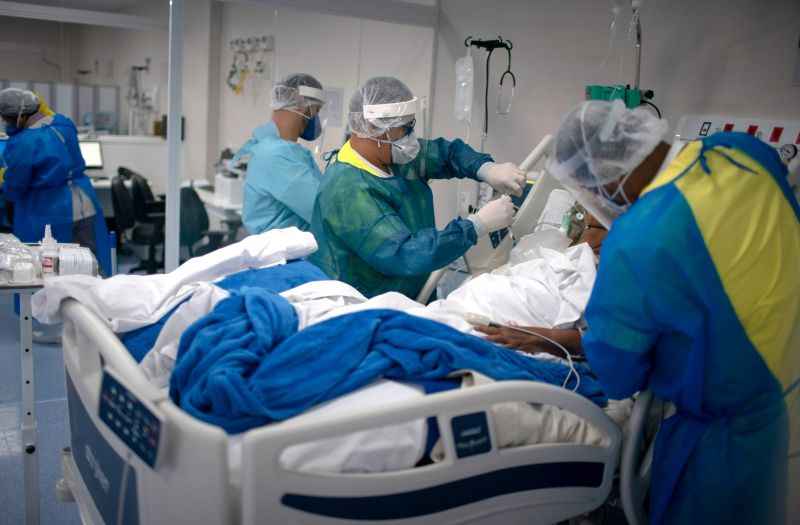RIO DE JANEIRO, BRAZIL – Less than a month ago, the group of InfoGripe’s researchers, of Fiocruz (Oswaldo Cruz Foundation), wrote in their weekly report that there was an alert to the authorities about the coronavirus in Brazil.
That week, in late October, 9 of the 27 Brazilian capitals recorded an upward trend in cases of Severe Acute Respiratory Syndrome (SARS), which is an indicator pointing to the progress of Covid-19 in the absence of tests.
Three weeks later, the scenario became somewhat more acute. Currently, 12 Brazilian capitals record a sharp or moderate upward trend in cases.

If in the past few weeks the increase was restricted mainly to the Northeastern states – with the exception of Florianópolis (SC), which had been steadily rising -, this time Southern and Southeastern states also began to cause concern, says Marcelo Gomes, InfoGripe’s coordinator.
“If we had localized situations before, now we see a more widespread and dispersed scenario across the country,” he says. “We’re talking about capitals, but we’ve seen an advance also in the interior of states”.
The advance towards the interior also leads to a scenario different from the “first wave” of infections, which began around March. At the time, the virus entered Brazil through the large centers – like São Paulo, the city with the highest number of cases until now – and it took some time to spread to other states and to the interior. This time there are active cases in these locations.
“Instead of localized cases, now the challenge is spread across the territory. There are many places in a similar situation, not only the capital, which can have an impact on the assistance network. It’s an additional challenge for us to deal with,” Gomes says.
Infogripe makes its projections based on data reported by the states to the Ministry of Health on SARS cases. The data refer to the weeks prior to the report, with data from epidemiological week 47, which ended on November 21st.
The city of São Paulo, for instance, was stabilizing but began to show an upward trend again. Vitória (ES) and Rio de Janeiro (RJ) had been on a downward trend for less than a month and are now recording a moderate increase. So was Porto Alegre (RS), which switched from a decline to stabilization.
The figures prove a sad diagnosis that was being evidenced by the daily numbers of cases and victims: the month of November marked the interruption of the drop of Covid-19 in Brazil.
“This spread of cases to other regions is precisely what led to the ‘Brazil curve’ – the sum of what is occurring across the country – to now also be a sign of renewed growth,” Gomes says.
Brazil has reached 6.2 million confirmed cases and 171,497 deaths by Covid-19, according to Thursday’s figures, November 26th, compiled by the media outlet consortium (UOL, Folha de S.Paulo, O Estado de S. Paulo, O Globo, G1 and Extra). The rolling average again stood at some 500 daily deaths.
This week, London’s Imperial College announced that the rate of coronavirus transmission in Brazil (the so-called Rt) stands at 1.3, the highest since May.
A rate above one means that an infected person will pass the virus to at least one other person, causing the disease to spread very quickly. The goal is to always reach a rate lower than one, which means that the number of new cases will eventually drop. The Brazilian transmission rate rose from 1.1 to 1.3 in just one week, between November 16th and 24th. In October, it stood at 0.68.
That period of decline in contagion had allowed the country to resume some normality, particularly in August, September, and October. Companies reopened offices, bars and restaurants and retail showed signs of a rebound; now the authorities will need to consider how to tackle the recent surge.
“It is important to monitor this growth, particularly in the state of São Paulo, where we have indications that hospitals are starting to fill,” writes economist Arthur Mota of Exame Research on Friday in a report on the economic impact of Covid in Brazil and the world.
Greater São Paulo has reached the highest number of hospitalizations for Covid-19 since August, and the scenario is repeated in other capitals. On Monday, the state government will announce if there will be new restrictions on quarantine amid the increase in cases.
Gomes says that even states in a downward trend need to be cautiously evaluated from now on. The drop does not often last long enough to effectively ensure that governments can adopt more flexible measures.
In other cases, the plateau (some stability in the number of cases) is inconvenient in itself: João Pessoa (PB) and Rio Branco (AC), for instance, have stabilized after experiencing growth earlier. In other words, their situation is worse than it was a few months ago, although for now, growth has stopped. The same is true for Florianópolis, which has seen constant growth, although with a stabilization in this last report.
Until a vaccine is available, fighting the pandemic and succeeding in making the contagion curve drop is very difficult and time-consuming, but even minor instances of negligence can push it back up much faster.
“There are a number of measures we can take, each in its own field: governments, companies, and individuals. None of them have the capacity to eradicate or stop contagions alone, but these groups need to work jointly,” says Gomes of Fiocruz. The scenario Brazil will be facing in the coming months will depend on everyone’s precautions today.
Source: Exame

